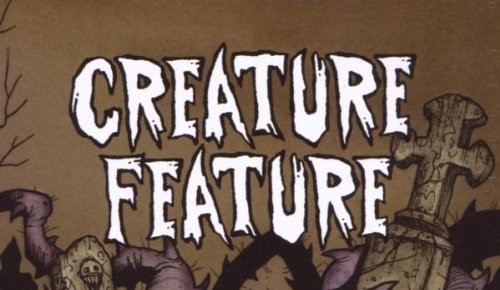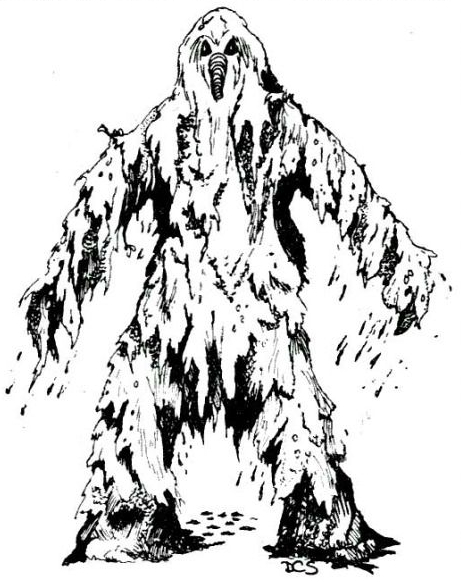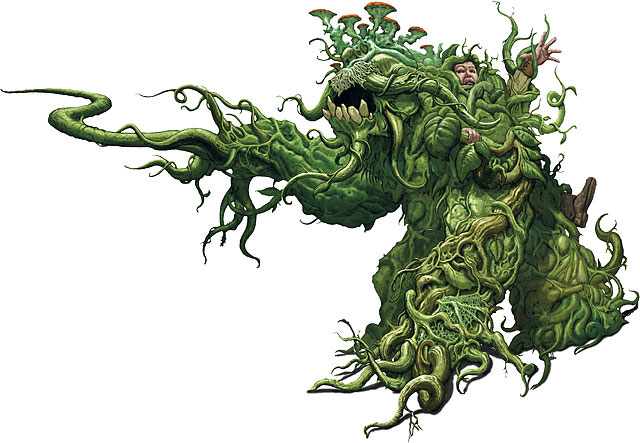
There have been a lot of monsters published in the Dungeons and Dragons game through the years, so many that cataloging them all would be a terribly arduous task. And with so many selections to choose from, a DM can be easily forgiven for missing some unique and downright cool monsters. And that is what this segment is hoping to address – by highlighting individual creatures and doing a deeper dive into their lore (both in game and in any mythologies or legends from our world) as well as taking a look at any fun tricks they have in their stat blocks. Hopefully you’ll come away with a desire to use these creatures for the first time, or in new and interesting ways.

The Shambling Mound is a creature that has appeared in every edition of the game, first appearing in Issue 3 of The Strategic Review for Dungeons and Dragons in 1974. It has since been included in a Monster Manual in each of the following editions and had its nature expanded on in 1997 in Dragon Annual #2 in “Ecology of the Shambling Mound” by Johnathan M. Richards. The creature has stayed largely the same throughout the editions, although 4th Edition did introduce a different variety of the creature known as the “stormrage shambler” that is capable of producing its own lightning strikes.
These creatures are often born during the height of storms when lightning strikes a pile of rotting vegetation. It is believed that certain types of fey magic can also create them, though none have ever been reported to have been created through arcane lighting bolts. The lightning strike grants the plant a primal intelligence, which then absorbs nearby plants and animals into its bulk, growing to a prodigious size to protect its root-stems from harm. Though it is not uncommon for these hunters to take vaguely humanoid shapes, this “central intelligence” is not located in the head, but rather in the central root-stem of the creature. Though made of plant matter, the shambling mound does not sustain itself through photosynthesis. Instead, the creature sustains itself on the plant and animal matter it brings into its bulk, feeding on itself as it stalks the swamps and rainforests that it calls home.
Though the creature has no sensory organs, it is able to both “hear” and “see” in a manner of speaking. The various plant fibers that cover its body are capable of picking up sound waves in the air, giving it 360-degree hearing. Likewise, it is also able to see in all directions, sensing the electrical fields of creatures within a certain range of it. However, the creature is effectively blind beyond that range.

The bulk and make up of these creatures also makes them incredibly resistant to damage from various sources, including fire and cold damage. Being creatures born of lightning means that attacks that deal lightning damage instead invigorate and heal the mound. Coupled with their natural camouflage, these creatures make for capable and dangerous ambush hunters, often striking only once its prey is literally on top of it.
These creatures are driven by their hunger, and that can be used to the advantage of other, more cunning creatures. There have been any number of stories of tribes of lizardfolk or other swamp dwelling creatures luring a shambling mound to an area with animal carcasses and then keeping it well fed, creating a natural guardian to areas they wish to have protected. As long as they keep the shambling mound fed, it is liable to stay where the meals are easy. Many a lizardfolk warren has been protected in this way.
The shambling mound is not cunning in its tactics. It simply tries to overwhelm the target, slamming it with its tendrils and trying to pull the hapless creature into its central mass where the mound can begin to absorb it. Perhaps the only saving grace is that the mound’s size limits how many creatures can be attacked in this manner. Still, one or two of these creatures in a swampy marsh, perhaps supported by other swamp creatures and vermin or an enemy druid (who could call on lightning spells to heal the shambling mounds) could spell incredible danger for an ill-prepared party.
